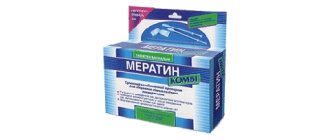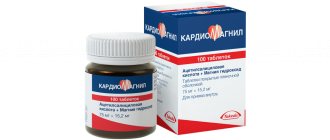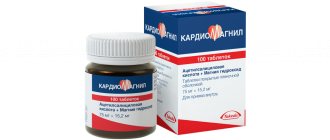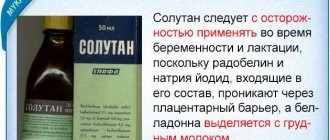Pharmacological properties
Pharmacodynamics
Oxymetazoline belongs to the group of alpha-agonists for topical use. Has a vasoconstrictor effect. When administered intranasally, it reduces swelling of the mucous membrane of the upper respiratory tract and nasal discharge. Restores nasal breathing.
Elimination of swelling of the nasal mucosa helps restore aeration of the paranasal sinuses and middle ear cavity, which reduces the likelihood of bacterial complications (sinusitis, sinusitis, otitis media). When used locally intranasally in therapeutic concentrations, it does not irritate or cause hyperemia of the nasal mucosa.
Oxymetazoline begins to act from 25 seconds. The duration of action of the drug is up to 12 hours.
Pharmacokinetics
When administered locally intranasally, oxymetazoline does not have a systemic effect. The half-life of oxymetazoline when administered intranasally is 35 hours. 2.1% of oxymetazoline is excreted by the kidneys and about 1.1% through the intestines.
Composition per 1 ml
| Dosage: | |||
| 0,01% | 0,025 % | 0,05 % | |
| Active substance: | |||
| oxymetazoline hydrochloride | 0.1 mg | 0.25 mg | 0.5 mg |
| Excipients: | |||
| citric acid monohydrate | 0.6093 mg | 0.6093 mg | 0.6093 mg |
| sodium citrate dihydrate | 3.8230 mg | 3.8230 mg | 3.8230 mg |
| glycerol | 24.3480 mg | 24.3480 mg | 24.3480 mg |
| benzalkonium chloride 50% solution | 0.1000 mg | 0.1000 mg | 0.1000 mg |
| purified water | up to 1 ml | up to 1 ml | up to 1 ml |
Description : transparent colorless or yellowish solution. Pharmacotherapeutic group : anticongestive agent (alpha-adrenergic agonist). ATX code : R01AA05.
Carefully
With increased intraocular pressure, chronic heart failure, arterial hypertension, angina pectoris; arrhythmias; chronic renal failure; in patients with prostatic hyperplasia with clinical symptoms (urinary retention); severe atherosclerosis; with hyperthyroidism; diabetes mellitus; pheochromocytoma; tachycardia; therapy with monoamine oxidase inhibitors (MAO) (including for up to 14 days after their discontinuation) and tricyclic antidepressants, as well as other drugs that increase blood pressure; porphyria; pregnancy, during breastfeeding.
Directions for use and doses
Intranasally.
Adults and children over 6 years old: 1 injection into each nostril 2-3 times a day.
If symptoms worsen or improvement does not occur within 3 days, you should consult your doctor. Use the recommended dose for no more than 7 days without consulting a doctor.
With frequent and prolonged use of the drug, the feeling of nasal congestion may reappear or worsen. If these symptoms appear, you should stop treatment and consult a doctor.
Indications for use of Rinostop
The drug is used:
- with nasal congestion and runny nose against the background of acute respiratory disease ;
- for chronic, including allergic rhinitis, accompanied by nasal congestion in short courses;
- for acute and chronic sinusitis ( sinusitis , sinusitis ), accompanied by nasal congestion in short courses;
- for acute and chronic otitis media to relieve swelling of the auditory tube connecting the middle ear to the nasopharynx;
- when conducting diagnostic studies (for example, rhinoscopy ) of ENT organs.
Side effect
Uncommon: burning or dryness of the mucous membranes of the nasal cavity, sneezing, nosebleeds.
In rare cases: after the effect of the drug wears off, a feeling of “stuffiness” in the nose (reactive hyperemia).
Frequency unknown: dryness of the mucous membranes of the mouth and throat, increased volume of secretions released from the nose.
Side effects caused by the systemic action of the drug:
Uncommon: Quincke's edema, itching.
Rarely: increased blood pressure, headache, dizziness, palpitations, tachycardia, anxiety, irritability, sleep disturbance (in children), nausea, insomnia, exanthema, blurred vision (if it gets in the eyes).
Very rare: restlessness, fatigue, drowsiness, sedation, hallucinations, convulsions, respiratory arrest (in infants).
Long-term continuous use of vasoconstrictor drugs can lead to tachyphylaxis, atrophy of the nasal mucosa and recurrent swelling of the nasal mucosa (rhinitis medicamentosa).
If any of the side effects indicated in the instructions get worse or you notice any other side effects not listed in the instructions, tell your doctor.
When is Rinostop contraindicated?
It is necessary to refuse the use of the drug:
- for chronic glaucoma;
- with atrophy of the nasal mucosa;
- for hypertension and hypertension;
- for heart rhythm disturbances: bradycardia, tachycardia;
- individual hypersensitivity to the components of the drug;
- after brain surgery;
- cerebrovascular accidents;
- during treatment with tricyclic antidepressants, MAO inhibitors.
Rinostop requires careful use in diabetes mellitus, thyroid diseases, high cholesterol levels, atherosclerotic changes in blood vessels, and prostate hyperplasia.
Overdose
Clinical signs of intoxication with imidazole derivatives can be nonspecific and unclear, since phases of hyperactivity are replaced by phases of depression of the central nervous system, cardiovascular and respiratory systems.
Symptoms: anxiety, restlessness, hallucinations, convulsions, decreased body temperature, lethargy, drowsiness, coma, constriction or dilation of pupils, fever, sweating, pallor, cyanosis, palpitations, bradycardia, arrhythmia, cardiac arrest, increased blood pressure, decreased blood pressure , nausea, vomiting, respiratory depression, respiratory arrest.
In children, an overdose can cause the development of symptoms from the central nervous system, such as: agitation, convulsions, coma, bradycardia, respiratory arrest, as well as an increase in blood pressure with a subsequent possible decrease in blood pressure.
Treatment: gastric lavage, taking activated carbon (in case of accidental ingestion of the drug); symptomatic.
In case of severe overdose, intensive therapy in a hospital setting is indicated. The use of vasoconstrictors is contraindicated.
Interaction with other drugs
When used concomitantly with monoamine oxidase inhibitors (during the previous 2 weeks and within 2 weeks after their discontinuation), tricyclic antidepressants or other drugs that increase blood pressure, an increase in blood pressure may occur. The drug slows down the absorption of local anesthetic drugs and prolongs their effect.
Co-administration of other vasoconstrictor drugs increases the risk of side effects.
Rinostop tablets - instructions, composition, dosage, side effects of use
Rinostop tablets
Rinostop _
Main physicochemical characteristics : white, round, flat tablets with beveled edges with the inscription “RINOSTOP” on one side;
Composition 1 tablet contains paracetamol 251 mg, pseudoephedrine hydrochloride 61.2 mg, chlorphenamine maleate 2.54 mg;
other ingredients: lactose monohydrate, corn starch, microcrystalline cellulose, hydroxypropylcellulose, magnesium stearate.
Release form of the medicine. Pills.
Pharmacotherapeutic group. Analgesics and antipyretics. Combined paracetamol preparations that do not contain psycholeptics. ATC code N02B E51.
Action of the medicine.
Pharmacodynamics. Rinostop is a combination drug that includes paracetamol, pseudoephedrine hydrochloride, chlorphenamine maleate. It has antipyretic, analgesic, vasoconstrictor, antihistamine, sedative, antitussive and bronchodilator effects, eliminates cold symptoms.
Paracetamol is a non-narcotic analgesic, has analgesic, antipyretic and mild anti-inflammatory effects.
Pseudoephedrine is a sympathomimetic with a moderate effect on alpha1-adrenergic receptors, produces vasoconstriction, reduces swelling, local exudative manifestations and hyperemia of the nasal mucosa, nasopharynx, and paranasal sinuses.
Chlorphenamine is a blocker of histamine H1 receptors, has an antiserotonin, antihistamine, weak anticholinergic, sedative effect, reduces the severity of allergic reactions mediated by the action of histamine, reduces capillary permeability, constricts nasal vessels; reduces local exudative manifestations, suppresses the symptoms of allergic rhinitis: sneezing, rhinorrhea, itching of the eyes and nose. The onset of action is 20 - 30 minutes, duration - 4 - 4.5 hours.
Telfast 120 mg - instructions, composition, dosage, side effects of use
Pharmacokinetics. Not studied.
Indications for use. Colds, flu, which are accompanied by diarrhea, headache, rhinitis with swelling of the nasal mucosa; allergic rhinitis.
Method of use and dose. Adults and children over 12 years of age are prescribed 1 tablet of Rinostop every 6 hours; children from 6 to 12 years old - ½ tablet every 6 hours. The duration of treatment is no more than 3 - 5 days.
Dosage in patients with impaired renal function.
A prolonged interval between doses is recommended, at least 8 hours.
Side effect. Side effects of paracetamol are usually moderate. Disorders of the digestive tract and allergic reactions may occur in the form of skin rashes, itching, swelling, Quincke's edema, dry mouth, anemia, thrombocytopenia, agranulocytosis, hepatotoxic effect, hemolytic anemia, pancytopenia, nephrotoxic effect.
Pseudoephedrine may increase blood pressure. Increased heart rate, anxiety, irritability.
Chlorphenamine sometimes produces drowsiness, loss of appetite, nausea, vomiting, diarrhea, or constipation.
Restrictions and contraindications in the use of the drug. Hypersensitivity to the components of the drug. Increased blood and intraocular pressure, heart disease, peptic ulcer of the stomach or duodenum, simultaneous use of MAO inhibitors. Children under 6 years old.
Octilia description and instructions for use of the drug.
Exceeding the permissible dose of the drug (overdose). Clinically, poisoning begins with nausea, vomiting, and anorexia. Exceeding the permissible dose of the drug (overdose) leads to seizures, hallucinations, increased body temperature, fever, dry mouth, redness of the skin, dilated pupils, tachycardia, increased blood pressure and arrhythmia, hepatotoxic effect, and in severe cases, liver necrosis develops.
In case of an overdose of Rinostop, measures must be taken within 4 hours. It is necessary to induce vomiting; if this is not possible, rinse the stomach. In the first 10 hours, N-acetylcysteine can be prescribed as an antidote. Anticonvulsants are prescribed (diazepam intravenously slowly).
Features of use. During treatment, peripheral blood parameters and the functional state of the liver are monitored.
The drug is prescribed with caution to persons with asthma, weakened liver and kidney function, hyperactivity of the thyroid gland, epilepsy, arrhythmia, glaucoma, blockage of the bile ducts, difficulty passing food from the stomach to the intestines, enlarged prostate, diabetes mellitus.
May date inaccurate results from laboratory tests that assess plasma glucose and uric acid concentrations.
During treatment with the drug, simultaneous consumption of alcoholic beverages should be avoided.
Bactilem - instructions, composition, dosage, side effects of use
Pregnancy and lactation.
There is no experience with the use of the drug during pregnancy and lactation. Therefore, the use of the drug is possible only when the expected benefit to the mother outweighs the potential risk to the fetus.
Impact on driving vehicles or working with complex mechanisms.
When using the drug, you should refrain from driving vehicles and working with potentially unsafe mechanisms.
Interaction with other drugs. Enhances the effects of MAO inhibitors, sedatives, ethanol. Ethanol enhances the sedative effect of chlorphenamine. Antidepressants, antiparkinsonian drugs, antipsychotic drugs, phenothiazine derivatives increase the risk of side effects (urinary retention, dry mouth, constipation). Glucocorticosteroids increase the risk of developing glaucoma. Paracetamol reduces the effectiveness of uricosuric drugs. Chlorphenamine simultaneously with MAO inhibitors and furazolidone can lead to hypertensive crisis, agitation, and hyperpyrexia. Tricyclic antidepressants enhance the symptomatic effect of Rinostop; simultaneous administration of halothane increases the risk of developing ventricular arrhythmia. Reduces the hypotensive effect of guanethidine, which, in turn, enhances the alpha-adrenergic stimulating activity of pseudoephedrine.
Features of conditions, shelf life and sales. . Keep out of the reach of children at a temperature not exceeding 25°C. Shelf life – 5 years.








